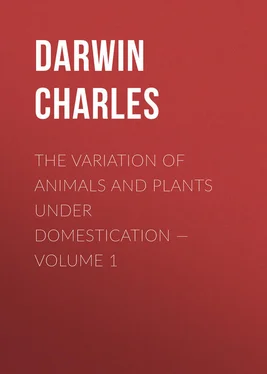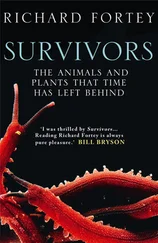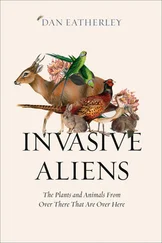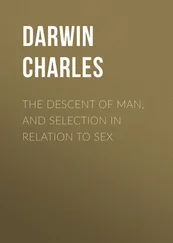Charles Darwin - The Variation of Animals and Plants under Domestication — Volume 1
Здесь есть возможность читать онлайн «Charles Darwin - The Variation of Animals and Plants under Domestication — Volume 1» — ознакомительный отрывок электронной книги совершенно бесплатно, а после прочтения отрывка купить полную версию. В некоторых случаях можно слушать аудио, скачать через торрент в формате fb2 и присутствует краткое содержание. Жанр: foreign_antique, foreign_prose, на английском языке. Описание произведения, (предисловие) а так же отзывы посетителей доступны на портале библиотеки ЛибКат.
- Название:The Variation of Animals and Plants under Domestication — Volume 1
- Автор:
- Жанр:
- Год:неизвестен
- ISBN:нет данных
- Рейтинг книги:5 / 5. Голосов: 1
-
Избранное:Добавить в избранное
- Отзывы:
-
Ваша оценка:
- 100
- 1
- 2
- 3
- 4
- 5
The Variation of Animals and Plants under Domestication — Volume 1: краткое содержание, описание и аннотация
Предлагаем к чтению аннотацию, описание, краткое содержание или предисловие (зависит от того, что написал сам автор книги «The Variation of Animals and Plants under Domestication — Volume 1»). Если вы не нашли необходимую информацию о книге — напишите в комментариях, мы постараемся отыскать её.
The Variation of Animals and Plants under Domestication — Volume 1 — читать онлайн ознакомительный отрывок
Ниже представлен текст книги, разбитый по страницам. Система сохранения места последней прочитанной страницы, позволяет с удобством читать онлайн бесплатно книгу «The Variation of Animals and Plants under Domestication — Volume 1», без необходимости каждый раз заново искать на чём Вы остановились. Поставьте закладку, и сможете в любой момент перейти на страницу, на которой закончили чтение.
Интервал:
Закладка:
With respect to the primitive colour of the horse having been dun, Colonel Hamilton Smith (2/41. 'Nat. Library' volume 12 1841 pages 109, 156 to 163, 280, 281. Cream-colour, passing into Isabella (i.e. the colour of the dirty linen of Queen Isabella), seems to have been common in ancient times. See also Pallas's account of the wild horses of the East, who speaks of dun and brown as the prevalent colours. In the Icelandic sagas, which were committed to writing in the twelfth century, dun-coloured horses with a black spinal stripe are mentioned; see Dasent's translation volume 1 page 169.) has collected a large body of evidence showing that this tint was common in the East as far back as the time of Alexander, and that the wild horses of Western Asia and Eastern Europe now are, or recently were, of various shades of dun. It seems that not very long ago a wild breed of dun- coloured horses with a spinal stripe was preserved in the royal parks in Prussia. I hear from Hungary that the inhabitants of that country look at the duns with a spinal stripe as the aboriginal stock, and so it is in Norway. Dun-coloured ponies are not rare in the mountainous parts of Devonshire, Wales, and Scotland, where the aboriginal breed would have the best chance of being preserved. In South America in the time of Azara, when the horse had been feral for about 250 years, 90 out of 100 horses were "bai-chatains," and the remaining ten were "zains," that is brown; not more than one in 2000 being black. In North America the feral horses show a strong tendency to become roans of various shades; but in certain parts, as I hear from Dr. Canfield, they are mostly duns and striped. (2/42. Azara 'Quadrupedes du Paraguay' tome 2 page 307. In North America Catlin (volume 2 page 57) describes the wild horses, believed to have descended from the Spanish horses of Mexico, as of all colours, black, grey, roan, and roan pied with sorrel. F. Michaux 'Travels in North America' English translation page 235, describes two wild horses from Mexico as roan. In the Falkland Islands, where the horse has been feral only between 60 and 70 years, I was told that roans and iron-greys were the prevalent colours. These several facts show that horses do not soon revert to any uniform colour.)
In the following chapters on the Pigeon we shall see that a blue bird is occasionally produced by pure breeds of various colours and that when this occurs certain black marks invariably appear on the wings and tail; so again, when variously coloured breeds are crossed, blue birds with the same black marks are frequently produced. We shall further see that these facts are explained by, and afford strong evidence in favour of, the view that all the breeds are descended from the rock-pigeon, or Columba livia, which is thus coloured and marked. But the appearance of the stripes on the various breeds of the horse, when of a dun colour, does not afford nearly such good evidence of their descent from a single primitive stock as in the case of the pigeon: because no horse certainly wild is known as a standard of comparison; because the stripes when they appear are variable in character; because there is far from sufficient evidence that the crossing of distinct breeds produces stripes, and lastly, because all the species of the genus Equus have the spinal stripe, and several species have shoulder and leg stripes. Nevertheless the similarity in the most distinct breeds in their general range of colour, in their dappling, and in the occasional appearance, especially in duns, of leg-stripes and of double or triple shoulder-stripes, taken together, indicate the probability of the descent of all the existing races from a single, dun-coloured, more or less striped, primitive stock, to which our horses occasionally revert.
THE ASS.
Four species of Asses, besides three zebras, have been described by naturalists. There is now little doubt that our domesticated animal is descended from the Equus taeniopus of Abyssinia. (2/43. Dr. Sclater in 'Proc. Zoolog. Soc.' 1862 page 164. Dr. Hartmann says ('Annalen der Landw.' b. 44 page 222) that this animal in its wild state is not always striped across the legs.) The ass is sometimes advanced as an instance of an animal domesticated, as we know by the Old Testament, from an ancient period, which has varied only in a very slight degree. But this is by no means strictly true; for in Syria alone there are four breeds (2/44. W.C. Martin 'History of the Horse' 1845 page 207.); first, a light and graceful animal, with an agreeable gait, used by ladies; secondly, an Arab breed reserved exclusively for the saddle; thirdly, a stouter animal used for ploughing and various purposes; and lastly, the large Damascus breed, with a peculiarly long body and ears. In the South of France also there are several breeds, and one of extraordinary size, some individuals being as tall as full-sized horses. Although the ass in England is by no means uniform in appearance, distinct breeds have not been formed. This may probably be accounted for by the animal being kept chiefly by poor persons, who do not rear large numbers, nor carefully match and select the young. For, as we shall see in a future chapter, the ass can with ease be greatly improved in size and strength by careful selection, combined no doubt with good food; and we may infer that all its other characters would be equally amenable to selection. The small size of the ass in England and Northern Europe is apparently due far more to want of care in breeding than to cold; for in Western India, where the ass is used as a beast of burden by some of the lower castes, it is not much larger than a Newfoundland dog, "being generally not more than from twenty to thirty inches high." (2/45. Col. Sykes Cat. of Mammalia 'Proc. Zoolog. Soc.' July 12, 1831. Williamson 'Oriental Field Sports' volume 2 quoted by Martin page 206.)
The ass varies greatly in colour; and its legs, especially the fore-legs, both in England and other countries — for instance, in China — are occasionally barred more plainly than those of dun-coloured horses. Thirteen or fourteen transverse stripes have been counted on both the fore and hind legs. With the horse the occasional appearance of leg-stripes was accounted for by reversion to a supposed parent-form, and in the case of the ass we may confidently believe in this explanation, as E. taeniopus is known to be barred, though only in a slight degree, and not quite invariably. The stripes are believed to occur most frequently and to be plainest on the legs of the domestic ass during early youth (2/46. Blyth in 'Charlesworth's Mag. of Nat. Hist.' vol 4 1840 page 83. I have also been assured by a breeder that this is the case.), as likewise occurs with the horse. The shoulder-stripe, which is so eminently characteristic of the species, is nevertheless variable in breadth, length, and manner of termination. I have measured one four times as broad as another, and some more than twice as long as others. In one light-grey ass the shoulder- stripe was only six inches in length, and as thin as a piece of string; and in another animal of the same colour there was only a dusky shade representing a stripe. I have heard of three white asses, not albinoes, with no trace of shoulder or spinal stripes (2/47. One case is given by Martin 'The Horse' page 205.); and I have seen nine other asses with no shoulder-stripe, and some of them had no spinal stripe. Three of the nine were light-greys, one a dark-grey, another grey passing into reddish-roan, and the others were brown, two being tinted on parts of their bodies with a reddish or bay shade. If therefore grey and reddish-brown asses had been steadily selected and bred from, the shoulder stripe would probably have been lost almost as generally and completely as in the case of the horse.
The shoulder stripe on the ass is sometimes double, and Mr. Blyth has seen even three or four parallel stripes. (2/48. 'Journal As. Soc. of Bengal' volume 28 1860 page 231. Martin on the Horse page 205.) I have observed in ten cases shoulder-stripes abruptly truncated at the lower end, with the anterior angle produced into a tapering point, precisely as in the above dun Devonshire pony. I have seen three cases of the terminal portion abruptly and angularly bent; and have seen and heard of four cases of a distinct though slight forking of the stripe. In Syria, Dr. Hooker and his party observed for me no less than five similar instances of the shoulder- stripe plainly bifurcating over the fore leg. In the common mule it likewise sometimes bifurcates. When I first noticed the forking and angular bending of the shoulder-stripe, I had seen enough of the stripes in the various equine species to feel convinced that even a character so unimportant as this had a distinct meaning, and was thus led to attend to the subject. I now find that in the E. burchellii and quagga, the stripe which corresponds with the shoulder-stripe of the ass, as well as some of the stripes on the neck, bifurcate, and that some of those near the shoulder have their extremities bent angularly backwards. The bifurcation and angular bending of the stripes on the shoulders apparently are connected with the nearly upright stripes on the sides of the body and neck changing their direction and becoming transverse on the legs. Finally, we see that the presence of shoulder, leg, and spinal stripes in the horse, — their occasional absence in the ass, — the occurrence of double and triple shoulder-stripes in both animals, and the similar manner in which these stripes terminate downwards, — are all cases of analogous variation in the horse and ass. These cases are probably not due to similar conditions acting on similar constitutions, but to a partial reversion in colour to the common progenitor of the genus. We shall hereafter return to this subject, and discuss it more fully.
Читать дальшеИнтервал:
Закладка:
Похожие книги на «The Variation of Animals and Plants under Domestication — Volume 1»
Представляем Вашему вниманию похожие книги на «The Variation of Animals and Plants under Domestication — Volume 1» списком для выбора. Мы отобрали схожую по названию и смыслу литературу в надежде предоставить читателям больше вариантов отыскать новые, интересные, ещё непрочитанные произведения.
Обсуждение, отзывы о книге «The Variation of Animals and Plants under Domestication — Volume 1» и просто собственные мнения читателей. Оставьте ваши комментарии, напишите, что Вы думаете о произведении, его смысле или главных героях. Укажите что конкретно понравилось, а что нет, и почему Вы так считаете.












